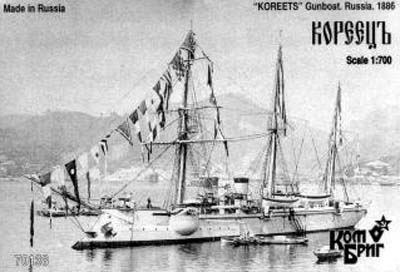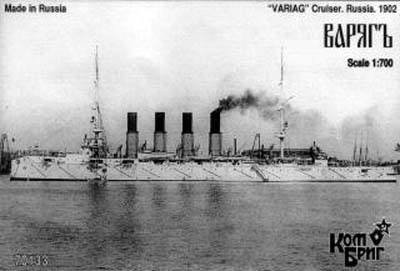 |
 |
The morning of February 8th, 1904 found two Russian warships at anchor in the harbor at Chemulpo (Inchon), Korea. Russia and Japan had been rattling sabers for quite some time, but the region was still at peace. Variag, a protected cruiser, was present at the neutral harbor of Chemulpo to prevent the Japanese from landing troops without opposition. Koreets, a gunboat, was acting as a dispatch courier between Korea and the Russian regional headquarters at Port Arthur, on Chinaís Liaotung peninsula. Koreets put to sea on the afternoon of the 8th, en route to Port Arthur. Just outside the harbor, she spotted a Japanese invasion force bound for Chemulpo. Accompanying the Japanese troop transports was a strong squadron of six cruisers and a number of torpedo boats. A few shots were fired with no damage to either side, and Koreets reversed course to return to the safety of the harbor. The Japanese force entered right behind. Under the protection of the cruiser squadron, troops began landing. By nightfall, 3000 Japanese soldiers were ashore in Chemulpo, ready for the march inland to Seoul. That same night, the a surprise torpedo attack by Japanese destroyers severely damaged the main Russian fleet at Port Arthur.
By morning of February 9th, the Japanese force had completed its primary mission and had left the harbor. An ultimatum was delivered to the Russian ships: Depart by 4 P.M. or be attacked in harbor. Variag and Koreets were prepared for battle. With Variag in the lead and shipís bands playing the Russian national anthem, the small force sailed to meet the vastly stronger Japanese squadron awaiting them. Variag and Koreets put up a brave fight, but the issue was never in doubt. After little more than an hour, the badly battered Russian ships retreated back into the harbor. Surviving crew members were evacuated to neutral vessels and both ships were scuttled.
On February 10th, 1904, Japan declared war on Russia.
Like all Combrig kits, these are packaged in strange, tiny paper boxes which are not at all encouraging at first glance. But the box doesnít really count, does it? Itís whatís inside that matters, and thatís very nice indeed. Variag and Koreets are recent releases, and it is easy to see that Combrig has come a long way since their earlier kits. Both of these models are as finely rendered and well cast as any other resin kit on the market.
to enlarge

Including the bowsprit, Koreets should build out to about 10 cm length. The double sided instruction sheet includes a very good exploded parts diagram showing exactly where everything belongs. A painting guide is included, in Russian of course. And a line drawing is sharp enough to be a good guide for rigging.

 |
 |



At 18 cm length, Variag is almost twice the length of Koreets. The instruction sheet included with my kit was a simple but adequate exploded parts diagram with no text. It looks like an interim document, and I wouldnít be at all surprised to find that it had been replaced by a standard Combrig instruction sheet in the near future. As with Koreets, some superstructure components are easier to cobble up from scratch than to relieve of the incorrect solid walls along the edges. Unlike Koreets, the boat davits are fairly detailed and substantial enough (though still quite fragile) to use.


Itís nice to know that models of these and other Russo-Japanese war ships are available. For something this obscure, it wouldnít be surprising to have to put up with crude kits that require a great deal of effort to turn into descent models. Some of the earlier Combrig kits are indeed lacking in detail and rather rough around the edges. But I canít find anything to make a serious complaint about with Variag (Combrig #70133) and Koreets (Combrig #70138). If you are interested in the period, these kits are highly recommended.


- Building the Combrig 1/700 Russian Battleship Kniaz Suvorov
- Russian battleship Kniaz Suvorov in 1/700 Combrig vs. Modelkrak a comparative review
- 1/700 Japanese Battleship Mikasa (Seals) photo's from the Gallery
- Combrig kit listing in Pacific Front's latest update
- Combrig #70138 Gunboat Koreets lists for $16.00
- Combrig #70133 Armored Cruiser Variag lists for $28.00
To be followed by a buildup article.
